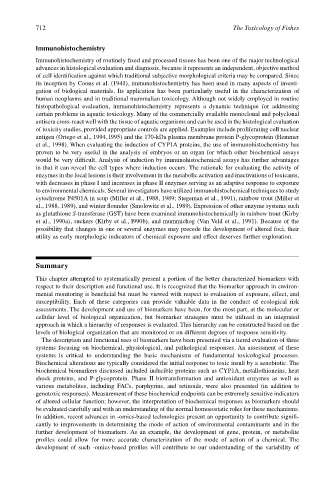Page 732 - The Toxicology of Fishes
P. 732
712 The Toxicology of Fishes
Immunohistochemistry
Immunohistochemistry of routinely fixed and processed tissues has been one of the major technological
advances in histological evaluation and diagnosis, because it represents an independent, objective method
of cell identification against which traditional subjective morphological criteria may be compared. Since
its inception by Coons et al. (1941), immunohistochemistry has been used in many aspects of investi-
gation of biological materials. Its application has been particularly useful in the characterization of
human neoplasms and in traditional mammalian toxicology. Although not widely employed in routine
histopathological evaluation, immunohistochemistry represents a dynamic technique for addressing
certain problems in aquatic toxicology. Many of the commercially available monoclonal and polyclonal
antisera cross-react well with the tissue of aquatic organisms and can be used in the histological evaluation
of toxicity studies, provided appropriate controls are applied. Examples include proliferating cell nuclear
antigen (Ortego et al., 1994, l995) and the 170-kDa plasma membrane protein P-glycoprotein (Hemmer
et al., 1998). When evaluating the induction of CYP1A proteins, the use of immunohistochemistry has
proven to be very useful in the analysis of embryos or an organ for which other biochemical assays
would be very difficult. Analysis of induction by immunohistochemical assays has further advantages
in that it can reveal the cell types where induction occurs. The rationale for evaluating the activity of
enzymes in the focal lesions is their involvement in the metabolic activation and inactivations of toxicants,
with decreases in phase I and increases in phase II enzymes serving as an adaptive response to exposure
to environmental chemicals. Several investigators have utilized immunohistochemical techniques to study
cytochrome P4501A in scup (Miller et al., 1988, 1989; Stegeman et al., 1991), rainbow trout (Miller et
al., 1988, 1989), and winter flounder (Smolowitz et al., 1989). Expression of other enzyme systems such
as glutathione S-transferase (GST) have been examined immunohistochemically in rainbow trout (Kirby
et al., 1990a), suckers (Kirby et al., l990b), and mummichog (Van Veld et al., 1991). Because of the
possibility that changes in one or several enzymes may precede the development of altered foci, their
utility as early morphologic indicators of chemical exposure and effect deserves further exploration.
Summary
This chapter attempted to systematically present a portion of the better characterized biomarkers with
respect to their description and functional use. It is recognized that the biomarker approach in environ-
mental monitoring is beneficial but must be viewed with respect to evaluation of exposure, effect, and
susceptibility. Each of these categories can provide valuable data in the conduct of ecological risk
assessments. The development and use of biomarkers have been, for the most part, at the molecular or
cellular level of biological organization, but biomarker strategies must be utilized in an integrated
approach in which a hierarchy of responses is evaluated. This hierarchy can be constructed based on the
levels of biological organization that are monitored or on different degrees of response sensitivity.
The description and functional uses of biomarkers have been presented via a tiered evaluation of three
systems focusing on biochemical, physiological, and pathological responses. An assessment of these
systems is critical to understanding the basic mechanisms of fundamental toxicological processes.
Biochemical alterations are typically considered the initial response to toxic insult by a xenobiotic. The
biochemical biomarkers discussed included inducible proteins such as CYP1A, metallothioneins, heat
shock proteins, and P-glycoprotein. Phase II biotransformation and antioxidant enzymes as well as
various metabolites, including FACs, porphyrins, and retinoids, were also presented (in addition to
genotoxic responses). Measurement of these biochemical endpoints can be extremely sensitive indicators
of altered cellular function; however, the interpretation of biochemical responses as biomarkers should
be evaluated carefully and with an understanding of the normal homoeostatic roles for these mechanisms.
In addition, recent advances in -omics-based technologies present an opportunity to contribute signifi-
cantly to improvements in determining the mode of action of environmental contaminants and in the
further development of biomarkers. As an example, the development of gene, protein, or metabolite
profiles could allow for more accurate characterization of the mode of action of a chemical. The
development of such -omics-based profiles will contribute to our understanding of the variability of

